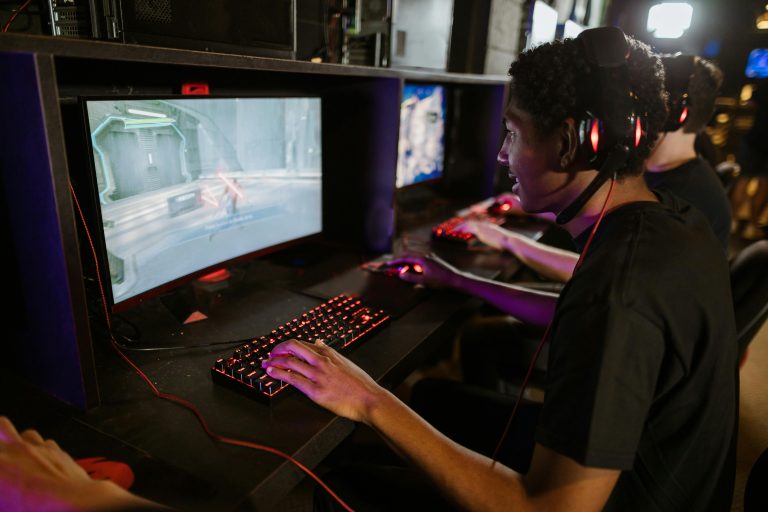
For decades, non-player characters (NPCs) have been the backbone of our virtual worlds, the shopkeepers, allies, and enemies that populate our favorite games. Yet, for all their importance, their behavior has largely been predictable. They follow pre-written scripts, patrol set paths, and react to the player with a limited set of if-then rules. You can see the seams in their digital consciousness. But a profound shift is underway, moving us from the era of scripted automations to the dawn of truly dynamic digital beings. This transformation is being powered by one of the most exciting technologies of our time: neural networks. These artificial brains are beginning to breathe a new kind of life into games, creating NPCs that are smarter, more adaptable, and unsettlingly human-like.
From Finite State Machines to Adaptive Neural Networks
To understand the revolution, we must first look at the old guard: Finite State Machines (FSMs). An FSM is a simple but effective programming model where an NPC exists in one of a finite number of states—like patrol, chase, or attack. Transitions between these states are triggered by specific conditions, such as if player is seen, then switch to chase state. While functional, this leads to robotic and exploitable behavior. Players quickly learn the rules and can manipulate them.
Neural networks shatter this rigid paradigm. Instead of being explicitly programmed, they are trained. By feeding a neural network vast amounts of data on human behavior, combat strategies, or dialogue patterns, it learns the underlying patterns and nuances. The result is an NPC that doesn’t recall a script but generates behavior based on a complex web of learned associations. It’s the difference between an actor reading lines and an improviser living a role.
The Building Blocks: How Neural Networks Power NPC Intelligence
At its core, a neural network is a series of algorithms loosely modeled on the human brain. It consists of layers of interconnected nodes, or neurons. During training, the network adjusts the strength of these connections to minimize the difference between its predictions and the desired outcome.
For NPCs, this can be applied in several key areas:
- Behavior and Movement: Networks can be trained on motion-capture data to create fluid, realistic animations. More advanced models, like Generative Adversarial Networks (GANs), can even create entirely new animations on the fly, ensuring no two movements are ever exactly the same.
- Decision Making: Reinforcement Learning, a type of machine learning, allows NPCs to learn optimal strategies through trial and error. An enemy soldier doesn’t just run for cover; it learns which type of cover is most effective, when to flank, and when to provide suppressing fire based on a dynamic assessment of the battlefield.
- Natural Dialogue: Large Language Models (LLMs), which are sophisticated neural networks, can generate context-aware dialogue. This means an NPC can have a unique conversation with a player, remembering past interactions and adapting its tone and responses accordingly, moving far beyond a static dialogue tree.
Real-World Examples: Games Leading the Charge
While still emerging, several projects and games have showcased the incredible potential of neural network-driven NPCs.
Ubisoft’s Commitment AI demonstration showed NPCs with stunningly realistic behavior. Characters in a crowded space didn’t just follow scripts; they made eye contact, grouped naturally, and reacted to the player’s presence with unique, subtle body language that made the world feel genuinely alive.
Perhaps the most famous example is the AI in Middle-earth: Shadow of Mordor and its sequel, Shadow of War. While not purely neural network-based, its groundbreaking Nemesis System uses procedural generation and complex AI to create unique enemy Orcs who remember their past encounters with the player. They bear physical and emotional scars from previous fights, creating emergent storytelling that feels deeply personal. This is a foundational step toward the adaptive, learning behavior that neural networks promise to deliver on a grander scale.
Looking forward, companies like Promethean AI are even using neural networks to assist developers in building worlds, hinting at a future where the very environments can intelligently react to player actions.
The Challenges and Ethical Considerations
Integrating neural networks into gaming is not without its significant hurdles. The immense computational power required for real-time inference is a major barrier. Running a complex neural network for every NPC in a bustling open world could bring even the most powerful hardware to its knees. Developers are tackling this through cloud-based AI, where processing is offloaded to remote servers, and through creating more efficient, optimized models.
Furthermore, there’s the challenge of predictability. While we want smarter NPCs, developers still need to maintain a fun and balanced experience. A neural network that becomes too good at a game could become an unbeatable foe, frustrating players. The goal is intelligence, not invincibility. This requires careful tuning and building constraints directly into the AI’s reward system during training.
Ethically, the rise of hyper-realistic NPCs blurs the line between simulation and reality. As these characters become more convincing, questions about player attachment, emotional manipulation, and the treatment of digital beings are likely to arise, demanding thoughtful discussion within the industry.
The Future of Game Design with Intelligent NPCs
The integration of neural networks is poised to redefine the very nature of game design. It moves us from authored narratives to emergent narratives—stories that are not written by a designer but created uniquely through the interaction between the player and the intelligent systems of the game. Quests could be generated dynamically based on an NPC’s personal, AI-driven goals. Every player’s journey could be truly one-of-a-kind.
This technology promises to create worlds that feel less like a theme park ride on a set track and more like a living, breathing ecosystem that exists and evolves independently of the player’s actions. The NPCs will no just be tools or obstacles; they will be inhabitants.
The dream of a truly living, breathing virtual world has driven game development for years. With the advent of neural networks, that dream is edging closer to reality. We are moving beyond the puppet with visible strings into an era where the digital people we meet in games can surprise us, challenge us, and connect with us on a deeper level. They will cease to be mere characters in a story and become partners in creating it. The future of gaming isn’t just about better graphics; it’s about better minds, and neural networks are the key to building them.






